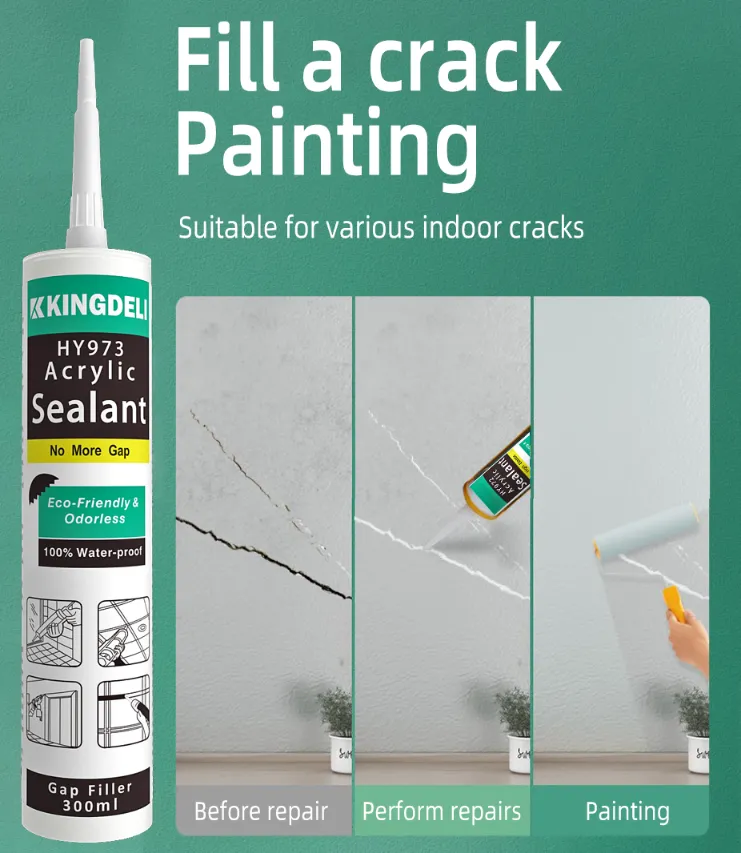Why Acrylic Silicone Sealant is the Best Choice for Vertical Surfaces


Introduction
Ever tried sealing a wall gap and watched the stuff slide down like a gloopy mess? Acrylic silicone sealant comes to the rescue. This water based mix blends acrylic’s paint friendly nature with silicone’s strong grip and stretch. It’s perfect for walls, window frames, or bathroom tiles since it stays put without dripping. Let’s check out why acrylic silicone sealant rocks for vertical jobs.
Understanding Acrylic Silicone Sealant
What is Acrylic Silicone Sealant?
Acrylic silicone sealant is a one part, water based goop mixing acrylic for a solid, paintable finish with silicone bits for better stickiness and bendiness. It’s low modulus, so it forms a smooth, tough bond that won’t crack easily. It dries by losing water, unlike pure silicone needing air moisture. This makes it kind to the planet with low bad smells (VOCs), so you don’t choke on fumes indoors. It’s like grabbing the best of acrylic and silicone in one tube.
How It Differs from Pure Acrylic or Silicone Sealants
Unlike plain acrylic, acrylic silicone shrinks way less, about 50% less, and holds up better against water. Pure acrylic might split on walls because it’s stiff. But acrylic silicone’s silicone boost adds stretch (up to 25% movement capability). Compared to pure silicone, it’s easier to paint and smells less, great for indoor jobs like baseboards. Pure silicone suits wet spots but isn’t paint friendly. Acrylic silicone hits a sweet spot for different tasks.
The Challenge of Sealing Vertical Surfaces
Common Problems with Traditional Sealants on Vertical Applications
Sealing walls can be a pain when sealants sag. Picture caulking a bathroom wall, and the bead slips before it sets. Total mess! Sagging causes up to 30% of DIY fails, especially in damp places like bathrooms. Old school latex sealants often lack the thickness to stay put. This leads to uneven lines or peeling. If the surface isn’t clean, the sealant might fail in weeks. It’s enough to make you rethink your weekend project.
Why Vertical Surfaces Demand Specialized Sealants
Gravity pulls hard on vertical jobs. It drags wet sealant down, especially on rough surfaces like drywall or wood trim. Temperature changes, like in a chilly room, make it worse. Substrates expand or shrink. Moisture, say on a kitchen wall, adds trouble too. You need a sealant that sticks tight during application and won’t crack later. Acrylic silicone’s non slump trick is made for this. It holds firm without needing fixes.
Key Properties That Make Acrylic Silicone Sealant Ideal for Vertical Surfaces
Non Slump Formula: No Dripping During Application
The cool thing about acrylic silicone sealant is its thick, no drip nature. It stays put when you squeeze it out, perfect for walls or ceilings. You can apply beads up to a quarter inch thick without sagging. It gets tack free in 10-30 minutes, so you don’t wait forever. Tip: hold your caulk gun at a 45 degree angle for a neat line. Trust me, it saves you from cleanup headaches.
Superior Adhesion to Diverse Vertical Substrates
This sealant grabs onto wood, plaster, concrete, and even slick surfaces like metal or glass. It sticks 60% better to rough surfaces than plain latex sealants, thanks to its silicone part. Put a small bead on scrap drywall. Let it set for 24 hours. Try pulling it off, it’s tough! This makes it great for vertical spots like window frames or tiles, where a strong grip keeps gaps sealed tight.
Flexibility and Durability Without Compromise
Acrylic silicone sealant doesn’t just stick; it bends too. It can stretch up to 25% to handle wall or door shifts. Plus, it fights mildew and water. It lasts 5-10 years indoors, even in steamy bathrooms.

Practical Applications for Vertical Surfaces
Indoor Uses: From Trim to Tiles
Acrylic silicone sealant shines indoors. It’s perfect for filling gaps around skirting boards, window frames, ceiling lines, or bathroom countertops. Its no drip formula means clean lines without climbing ladders to fix messes. For a pro look, stick masking tape along edges before caulking. Smooth with a wet finger and pull the tape off. This hack gives you slick results. Plus, it’s paintable, so your trim matches your walls perfectly.
Outdoor and Mixed Use Scenarios
It works for low exposure outdoor gaps, like door wall joints, where weather resistance matters. It holds up okay against rain or sun. Check it yearly for wear, especially in tough climates. But for heavy outdoor use, pure silicone might be better for UV resistance. Still, acrylic silicone does the job for lighter tasks.
Application Tips and Best Practices
Surface Preparation for Optimal Results
Prep is everything. Clean surfaces with alcohol or a household cleaner. Scrape off old caulk with a putty knife. Tough bits might need a sealant remover. Make sure the surface is dry and above 5°C.
Step by Step Application Guide
Here’s the deal: Load your caulk gun with a cartridge, like Kingdeli’s 280ml Gap Filler. Cut the nozzle at a 45 degree angle. Squeeze a steady bead along the seam. Move the gun slowly. Smooth it with a soapy finger or a caulking tool for a clean finish. Let it cure for 24 hours before painting or getting wet. Got too much? Wipe it with a damp cloth before it sets. Easy peasy!
Tools and Safety Essentials
You need a caulk gun, utility knife, cleaning solution, and soapy water for cleanup. Wear gloves to avoid skin itch. Work where air flows, low VOC or not, fumes can build up. The water based formula makes cleanup a breeze. Just wipe tools with a wet cloth.
Why Choose Acrylic Silicone Sealant Over Alternatives?
Comparison with Other Sealants for Vertical Work
Here’s the scoop:
- Pure Silicone: Hard to paint, costs more, smells stronger. Great for wet areas but too much for most indoor vertical jobs.
- Latex: Slumps more, less tough. Acrylic silicone’s nodrip and water resistance beat it out.
- Polyurethane: Sticks better, stretches more, but isn’t paintable and costs more. Save it for heavy outdoor work, not simple trim.
Acrylic silicone is just right: cheap, easy, and solid for vertical tasks.
Long Term Value and Sustainability
At about $5-10 per cartridge, acrylic silicone saves cash with no waste from its no drip nature. Its low VOC formula and recyclable packaging fit green building trends.
FAQ
Q: Can I paint over acrylic silicone sealant?
A: Yup, it’s paintable after 24 hours. Perfect for matching wall or trim colors, unlike pure silicone.
Q: How long does it take to cure on a vertical surface?
A: Tack free in 10-30 minutes, fully set in 24-48 hours. Warm, humid air speeds it up. Keep it dry till then.
Q: Is acrylic silicone sealant good for bathrooms or kitchens?
A: Totally, it’s waterproof and fights mildew for wall or tile joints. Just keep the room aired out.
Q: What’s the shelf life of acrylic silicone sealant?
A: About 12 months in unopened cartridges. Store it cool and dry for best results.
Q: Can it be used outdoors on vertical surfaces?
A: Works for low exposure spots like door frames. For harsh weather, try silicone enhanced types for extra sun protection.
